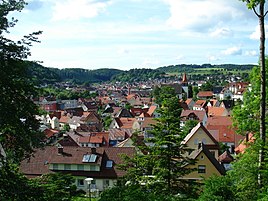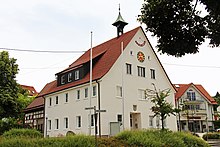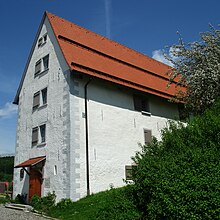Onstmettingen
|
Onstmettingen
City of Albstadt
|
|
|---|---|
| Coordinates: 48 ° 17 ′ 10 ″ N , 9 ° 0 ′ 8 ″ E | |
| Height : | 801 m |
| Area : | 20.6 km² |
| Residents : | 4968 (Jun. 30, 2020) |
| Population density : | 241 inhabitants / km² |
| Incorporation : | 1st January 1975 |
| Postal code : | 72461 |
| Area code : | 07432 |
|
Location map of Onstmettingen in the city of Albstadt
|
|
|
Onstmettingen from Hohberg to the north
|
|
Onstmettingen is the third largest district of Albstadt in the Zollernalb district in Baden-Württemberg . It is located on the Swabian Alb , about halfway between Stuttgart and Lake Constance .
geography
The source of the Schmiecha is located in Onstmettingen, the northernmost district of Albstadt . The northern boundary of the municipality is formed by the Albtrauf , i.e. the northern steep drop of the Swabian Alb with the Zeller Horn and the Raichberg .
history
Recent discoveries show that Onstmettingen was around 500 BC. Was settled. Onstmettingen was mentioned in a document in 1064 when a Count von Habsburg bequeathed a donation to the Ottmarsheim monastery in Alsace, including the property "Ansmutingen". In 1403 the village "Anschmattingen" came to Württemberg together with the rule Schalksburg and was assigned to the office of Balingen . It is believed that the name Onstmettingen was derived from the first name Ansmut. The place originally consisted of two settlements, Oberhofen and Unterhofen, each with its own church.
In the 18th century there was a strikingly large number of blacksmiths in Onstmettingen, some of which manufactured and repaired agricultural equipment, but some also produced hunting rifles. On this basis, a weighing industry developed , in which Pastor Philipp Matthäus Hahn was particularly involved from 1764 to 1770. Hahn built his first large astronomical clocks in Onstmettingen. In the period that followed, the manufacture of precision tools and the textile industry were added.
From 1806 the place, subordinate to the Oberamt Balingen , belonged to the newly established Kingdom of Württemberg and from 1919 to the national state of the same name .
In 1828 Onstmettingen was granted market rights.
Onstmettingen came to the district in 1934 and to the district of Balingen in 1938 and, as part of the district reform in 1973, to the Zollernalb district .
On January 1, 1975, Onstmettingen became part of the newly founded large district town of Albstadt as part of the community reform , although a large part of the Onstmettingen population had voted against the incorporation
Population development
| year | Residents |
|---|---|
| 1961 | 4715 |
| 1970 | 5714 |
| 1971 | 5815 |
politics
mayor
Mayor
- 1975-2004: Helmut Merz
- 2004–2009: Wolfgang Hähnle
- since 2009: Siegfried Schott
coat of arms
The blazon of the coat of arms of Onstmettingen shows under a golden shield head, a lying black stag pole , in black a golden scale .
Explanation: The scales point to the once very important scale construction on site, the stag bar to the Württemberg history of the place. The coat of arms has been in use since 1925 and was officially confirmed in 1950.
Culture and sights
Onstmettingen is on Hohenzollernstrasse .
Museums
Philipp-Matthäus-Hahn-Museum
The old Johanneskirche in Oberhofen, built around 940, was a simple hall building in Romanesque style. It was secularized in the course of the Reformation and first used as a granary, then as a poor house, later as a factory and as a residential building. Then in the 1980s, when the thought of demolishing the dilapidated building, a group of citizens campaigned for its preservation and formed the “Box Working Group”. The building was saved from demolition and completely renovated from 1981 to 1989 with a lot of initiative. In 1989 the Philipp-Matthäus-Hahn- Museum moved here . On the east side, the former sanctuary, traces of painting can still be seen, namely a black sun, which alludes to the fact that the sun darkened when Jesus died on the cross (Luke 23:44). The painting will therefore have been a crucifixion scene in which John (the church patron) and Mary stood under the cross.
Riedschule scales collection
In the former Riedschule there is a large collection of scales from the Philipp-Matthäus-Hahn-Museum. Over 600 scales from around 50 manufacturers are on display , including precision scales and measuring devices from the calibration authorities. The nucleus and the development of scale construction in the region are also documented.
Buildings
Churches
- The church and parish of St. Maria in Unterhofen was mentioned as early as 1275. It has been a Protestant parish church since the Reformation and is now called Phlipp-Matthäus-Hahn-Kirche . The basement of the church tower is still Romanesque, but the nave was rebuilt in 1887/88. Below the church there is a park of around 70 ares .
- Most of the Catholics who moved here after the Second World War built their own church in 1955, which is also called St. Maria .
Building of the old Pietist community
Evangelical Philipp-Matthäus-Hahn-Church in Onstmettingen
Catholic Church of St. Maria in Onstmettingen
- The New Apostolic Church is also located with a congregation.
Secular buildings
A historical pumping station from 1909, the so-called Pumphäusle, stands at the eastern Schmiecha spring. Here the first water pipe network was fed with a piston pump. The piston pump was initially powered by a gas engine, but in 1923, when the municipality received electricity, the gas engine was replaced by an electric motor.
caves
The Linkenboldshöhle , a 140 meter long horizontal cave , is located around two kilometers southeast of Onstmettingen and was discovered in 1761. Originally access was only possible through a natural shaft hole, in 1876 a convenient entrance was created with a tunnel and since 1975 it has been provided with electrical lighting. In the same year, maintenance was transferred to the Swabian Alb Association local group Onstmettingen. In the cave there are various sintered forms such as sintered flags, sintered curtains and stalactites . Tours are led by trained cave guides from the Swabian Alb Association.
Other caves in the Onstmettingen district are the Hohenzollern Cave, discovered in 1912 (depth 25 meters) and the Mackensen Cave, discovered in 1915 (depth 30 meters). Both caves are in a crevice on the hanging stone on the Alb eaves . There are also some smaller caves known.
Sports
Onstmettingen has a ski lift with a length of 200 meters with floodlights.
Sports clubs:
- The table tennis club Onstmettingen 1958 e. V. is a table tennis club with around 90 members. In 2008 the association celebrated its 50th anniversary. The first team plays in the district league group 1 . Two active men's teams are currently officially registered.
- The tennis club Onstmettingen 1976 e. V. offers five outdoor courts (sand) and a modern two-field hall (granulate) on its facility in the Zaislen sports area.
- The ski club Onstmettingen e. V. offers winter sports (skiing and snowboarding), mountain biking, Nordic walking , triathlon and ski gymnastics. The Onstmettingen Ski Club was founded in 1924 and, with around 1000 members (as of 2006), is one of the largest clubs in Onstmettingen.
- The football club Onstmettingen 1910 e. V. plays its home games on the Zaislen sports grounds . The first active team has been playing in the Zollern district league since the 2009/2010 season .
- The Turnverein Onstmettingen 1899 e. V. offers handball, athletics, running clubs, parent-child gymnastics, preschool gymnastics, gymnastics, back training and more. With over 1000 members (as of 2011) it is the largest association in Onstmettingen.
- The Onstmettingen shooting club e. V. has 177 members (2009). It offers a pistol and air rifle stand (in the hall), as well as 50 m small caliber and 100 m small caliber (in the open air area) and an archery range (outside in summer and in the hall in winter). German champions and one Olympic participant have already emerged from its ranks.
- The cycling and motorsport club Onstmettingen was founded in 1921 as the "Onstmettinger Radfahrverein". After the Second World War it became the Motorsport Club Onstmettingen. and Motorsportclub Onstmettingen eV ".
Culture
societies
- The Musikverein Onstmettingen, Großes Blasorchester Albstadt e. V., was founded in 1865. The maximum level orchestra has around 50 active musicians. In addition to the large wind orchestra, the club also includes the Minis, the youth orchestra, the “jukebox”, the folk music Talgang Nord and the brass ensemble. Musically, the large wind orchestra moves in the field of symphonic wind music.
- The local branch of the Swabian Alb Association has existed since 1891 and has around 500 members (as of 2017). In addition to hiking, the Swabian Alb Association is mainly dedicated to regional culture, maintaining the network of trails and nature conservation.
Charitable institutions
- The local branch of the German Red Cross was founded in 1934. In addition to the medical service at Onstmettinger events, the local HvO group is also on call . Two youth Red Cross groups that cooperate with the school medical service of the Schillerschule Onstmettingen round off the offer.
education
With the Schillerschule, Onstmettingen has a primary, secondary and technical secondary school .
traffic
From Onstmettingen, the low mountain range Thanheimer Steige (also called Stich ) leads into the foothills of the Alb to Bisingen.
Personalities
Sons and daughters of the church
- Philipp Gottfried Schaudt (1739–1809), schoolmaster and mechanic, employee of Philipp Matthäus Hahn
- Ernst Ritter (1858–1944), Oberamtmann in Württemberg
Personalities who have worked on site
- Philipp Matthäus Hahn (1739–1790), theologian, inventor of astronomical clocks and scales as “mechanic pastor”, was pastor in Onstmettingen from 1764 to 1770. He is considered the founder of weighing scales on the Westalb.
literature
- Johannes Raster: Pictures from Onstmettingen's local history . Onstmettingen 1950.
Web links
- District information on the website of the city of Albstadt
Individual evidence
- ^ Federal Statistical Office (ed.): Historical municipality directory for the Federal Republic of Germany. Name, border and key number changes in municipalities, counties and administrative districts from May 27, 1970 to December 31, 1982 . W. Kohlhammer, Stuttgart / Mainz 1983, ISBN 3-17-003263-1 , p. 540 .
- ↑ Federal Statistical Office: District Balingen, The city and districts of Baden-Württemberg in words and numbers, Issue 63 , (pdf)
- ↑ So it was in Onstmettingen, issue 14: Our water , edited by the Onstmettingen working group. V., 1996
- ↑ So it was in Onstmettingen, issue 12: The Linkenboldshöhle near Onstmettingen , published by the Onstmettingen working group. V., 1994












